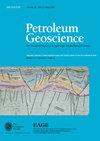埃及东Beni Suef盆地上白垩统含油气系统:综合地质与二维盆地建模方法
IF 2.1
4区 地球科学
Q3 GEOSCIENCES, MULTIDISCIPLINARY
引用次数: 0
摘要
利用地质建模和二维盆地建模相结合的方法,研究了埃及中北部东贝尼苏夫盆地(EBSB)的构造地层演化及其对上白垩统含油气系统的影响。本研究采用了2个相交地震剖面和3口勘探井。地质模型确定了盆地的构造和几何格架,为后续的二维盆地建模奠定了基础。利用镜质组反射率和校正后的温度数据,对开发的盆地模型进行了校准和微调。模拟结果表明,Abu Roash“F”烃源岩成熟度范围从盆地边缘的早期油窗到中部的主油窗。晚白垩世圈闭形成后始新世为主要生烃期。生成的油气在横向和纵向上都有运移,最有可能从盆地中部向盆地边缘运移,特别是向东运移到构造圈闭。该模型预测,由于上覆岩和正断层的封闭能力不强,沉积速率较低。除了Abu Roash“E”水库的厨房外,还建议在盆地西北部为Abu Roash“G”水库增加一个厨房区。通过整合地质学、地球物理学和地球化学的基本方面,盆地建模提供了一种强有力的方法来检查地下地质,重建沉积盆地随时间的演化,并评估相关石油系统的潜在前景(Poelchau等人,1997;Hantschel and Kauerauf 2009;Peters et al. 2017)。盆地模型的可靠性和有效性需要综合多学科数据和方法,以最大限度地了解对石油系统的各种相互关联的控制(Ungerer等,1990;Rudkiewicz et al. 2000;Verweij et al. 2000;Mosca et al. 2017;Khan et al. 2022;Mahdi et al. 2022)。综合盆地建模研究通过研究不同的情景和假设,有助于约束提出的假设,最大限度地减少潜在的不确定性,并降低勘探风险。本文章由计算机程序翻译,如有差异,请以英文原文为准。
The Upper Cretaceous Petroleum System of the East Beni Suef Basin, Egypt: An Integrated Geological and 2D Basin Modeling Approach
We integrated geological and 2D basin modeling to investigate the tectonostratigraphic evolution of the East Beni Suef Basin (EBSB) of north central Egypt and its implications for the Upper Cretaceous petroleum system. Two intersecting seismic sections and three exploration wells were used for this study. The geological model defines the structural and geometrical framework of the basin, which formed the basis for subsequent 2D basin modeling. The developed basin models were calibrated and fine-tuned using vitrinite reflectance and corrected temperature data. Modeling results indicate that the Abu Roash “F” source rock maturity ranges from the early oil window at the basin margins to the main oil window in the center. The main phase of hydrocarbon generation occurred during the Eocene after trap formation in the Late Cretaceous. Generated hydrocarbons have migrated both laterally and vertically, most likely from the central part of the basin toward the basin margins, particularly eastward to the structural traps. The model predicts low accumulation rates for the EBSB, which are caused by the ineffective sealing capacity of the overburden rocks and normal faults. In addition to the proven kitchen for the charging of the Abu Roash “E” reservoirs, an additional kitchen area to the northwest of the basin is suggested for the Abu Roash “G” reservoirs.
Basin modeling provides a powerful approach to examining subsurface geology, reconstructing the evolution of sedimentary basins through time, and evaluating potential prospects of the associated petroleum systems by integrating fundamental aspects from geology, geophysics, and geochemistry (Poelchau
et al.
1997; Hantschel and Kauerauf 2009; Peters
et al.
2017). Reliability and validity of basin models require integrating multidisciplinary data and methods to maximize the understanding of the various interrelated controls on petroleum systems (Ungerer
et al.
1990; Rudkiewicz
et al.
2000; Verweij
et al.
2000; Mosca
et al.
2017; Khan
et al.
2022; Mahdi
et al.
2022). Integrated basin modeling studies contribute to constraining the put-forward assumptions, minimizing the potential uncertainties, and reducing exploration risk by investigating different scenarios and hypotheses.
求助全文
通过发布文献求助,成功后即可免费获取论文全文。
去求助
来源期刊

Petroleum Geoscience
地学-地球科学综合
CiteScore
4.80
自引率
11.80%
发文量
28
审稿时长
>12 weeks
期刊介绍:
Petroleum Geoscience is the international journal of geoenergy and applied earth science, and is co-owned by the Geological Society of London and the European Association of Geoscientists and Engineers (EAGE).
Petroleum Geoscience transcends disciplinary boundaries and publishes a balanced mix of articles covering exploration, exploitation, appraisal, development and enhancement of sub-surface hydrocarbon resources and carbon repositories. The integration of disciplines in an applied context, whether for fluid production, carbon storage or related geoenergy applications, is a particular strength of the journal. Articles on enhancing exploration efficiency, lowering technological and environmental risk, and improving hydrocarbon recovery communicate the latest developments in sub-surface geoscience to a wide readership.
Petroleum Geoscience provides a multidisciplinary forum for those engaged in the science and technology of the rock-related sub-surface disciplines. The journal reaches some 8000 individual subscribers, and a further 1100 institutional subscriptions provide global access to readers including geologists, geophysicists, petroleum and reservoir engineers, petrophysicists and geochemists in both academia and industry. The journal aims to share knowledge of reservoir geoscience and to reflect the international nature of its development.
 求助内容:
求助内容: 应助结果提醒方式:
应助结果提醒方式:


